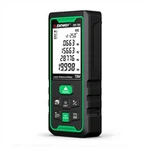Excuse me, how to test the ignition coil on the car with multimeter?
1. The multimeter can only measure its on-off and resistance value for reference. However, most ignition coil faults are turn-to-turn short circuit (high voltage breakdown), which can't be measured by multimeter, or the input terminal (primary) can be instantly connected with battery electricity, and the output terminal will have high voltage output (secondary).
2. The multimeter can measure the resistance of two high-voltage terminals, but it cannot judge the fault of the ignition coil.
3. The voltage value between terminals of independent ignition coil plug varies with different coils, so it is impossible to judge the quality of ignition coil.
4. Any coil has a secondary coil and a primary coil. The coils used in the distributor are all output by a high-voltage head and then distributed to each cylinder.
Extended data:
Structure of multimeter:
1. Header:
The meter head of the multimeter is a sensitive galvanometer. The dial on the meter head is printed with various symbols, tick marks and numerical values.
The symbol A-V-Ω indicates that this meter is a multimeter that can measure current, voltage and resistance. There are many scale lines printed on the dial, among which the right end marked with "Ω" is the resistance scale line, whose right end is zero and the left end is ∞, and the distribution of scale values is uneven.
The symbol "-"or "DC" means DC, "~" or "AC" means AC, and "~" means the common scale line of AC and DC. A few lines of numbers under the scale line are scale values corresponding to different gears of the selector switch.
There is also a mechanical zero adjustment knob on the meter head to correct the zero position of the pointer at the left end.
2. Select the switch:
The selector switch of multimeter is a multi-gear rotary switch. Used to select measurement items and ranges. General multimeter measurement items include: "MA"; DC current, "V (-): DC voltage," V (~) ":AC voltage," Ω ":resistance. Each measurement item is divided into several different ranges for selection.
3, stylus and stylus jack:
The pens are divided into red and black. When using, the red stylus should be inserted into the jack marked with "+",and the black stylus should be inserted into the jack marked with "-".
4. Header (pointer):
It is a high-sensitivity magnetoelectric DC ammeter, and the main performance indexes of the multimeter basically depend on the performance of the meter head. The sensitivity of the meter refers to the DC current value flowing through the meter when the pointer of the meter deflects at full scale. The smaller this value, the higher the sensitivity of the meter. The greater the internal resistance when measuring voltage, the better its performance.
There are four tick marks on the meter head, and their functions are as follows:
The first line (from top to bottom) is marked with R or Ω, which indicates the resistance value. When the changeover switch is in the ohm block, this scale line is read.
The second line is marked with ∽ and VA, indicating the values of AC and DC voltage and DC current. When the change-over switch is in the AC and DC voltage or DC current block and the range is in other positions except AC 10V, this scale line is read.
The third line is marked with 10V, indicating the AC voltage value of 10V. When the change-over switch is in the AC and DC voltage range and the range is 10V, this scale line is read.
The fourth one is labeled dB, which indicates the audio level.
5. Header (digital):
The meter head of a digital multimeter is generally composed of an A/D (analog/digital) conversion chip+peripheral components+liquid crystal display, and the accuracy of the multimeter is affected by the meter head. The digital multimeter converted by the A/D chip is also generally called 3 1/2 digital multimeter, 4 1/2 digital multimeter and so on.
The most commonly used chips are ICL7106(3-and-a-half LCD manual range classic chip, the subsequent versions are 7106A,7106B,7206,7240, etc.), ICL7129(4-and-a-half LCD manual range classic chip) and ICL7107(3-and-a-half LED manual range classic chip).
6, measuring line:
The measuring circuit is used to convert all kinds of measured signals into tiny DC current suitable for meter measurement. It consists of resistors, semiconductor components and batteries.
It can turn various measured (such as current, voltage, resistance, etc.) and different measuring ranges into a certain amount of tiny DC current after a series of treatments (such as rectification, shunt, voltage division, etc.) and send it to the meter for measurement.
7. Transfer switch:
Its function is to select different measuring lines to meet the measurement requirements of different types and ranges. The change-over switch is generally a circular dial with functions and ranges marked around it.






